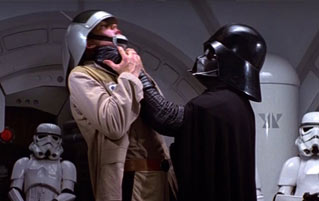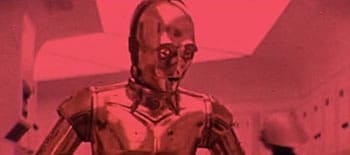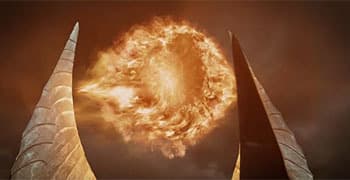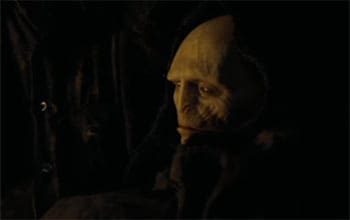5 Fan Edits That Blur The Line Between Insane And Genius

Changing your favorite film to fit a different idea is a fairly common practice. I've removed all of the dinosaur scenes from Jurassic Park, thus rendering it a pleasant look at some scientists and their fascination with tropical plant life. I then added those dinosaur scenes to Love Actually, because I watched that movie, and found not one dinosaur scene. Not even a reference to them. That's not love.
But my minor attempts at fixing flawed movies is nothing compared to these five instances. Here, people took classic works and transformed them into things that expand the realm of the human mind. And by that, I mean that they ruined them so utterly that they made them kind of great again.
Star Wars Was Turned Into A Grindhouse Extravaganza
Somehow, the original Star Wars trilogy digs itself into your brain and gets lodged there, like a pleasant memory or a half-finished stabbing. Every alien grunt, every tiny musical cue, and every passing Stormtrooper is etched in my headspace. Sure, I could've become well-versed in art or technology, but instead, I can recreate the entire Jabba's Sail Barge sequence, beat by beat, with sock puppets at a moment's notice. Get a refund on those Broadway tickets, wife. Shoes Off Theatre is in session. Turn off your cell phones, please.

The one on the left is Han Solo. The one on the right is everyone else.
I'm sure it's exactly like this for every other fan of Star Wars. So when I hear that a new fan edit of the movies has come out, I'm always apprehensive, especially when they claim to have improved stuff. It's like a serial killer movie, when the murderer says "Oh, you'll find them" to the police, and you absolutely know that by "them," he means "human limbs in three different time zones."
But by the time you see that R2-D2 has subtitles, you realize that The War of the Stars is not meant to improve Star Wars. It's simply there to show you what Star Wars would've been like if a sleazy drive-in theater owner from Buffalo, New York had financed it. "Give the little robot turtle fucker some dialogue. Who's gonna sit through beeps?"

Catchphrase: Established.
It would've been easy to just make the footage grainy, but The Man Behind The Mask went above and beyond in turning this into an excruciatingly entertaining experience. A big thing that people forget about grindhouse movies is that there can be a lot of long stretches of dialogue. Modern "grindhouse" films like to reinterpret the genre as all fake blood and skimpy outfits, but even in kung fu classics that would have names like A Thousand Fists For Brother Chuck or One Kick And It's Over, Sucka, there are talking scenes that feel like they last for a goddamn year. You will go through two birthdays before the white guy that is definitely not Asian and the one Asian guy that they hired get done discussing honor.
That's what The War of the Stars understands. It added in a lot of previously deleted scenes, like Biggs Darklighter talking to Luke at the beginning of the film, and god, do they not need to be there. Sorry for all of you die-hard Biggs fans out there, but the most we need of that guy is a shot of his X-Wing exploding and no allusion whatsoever made to his name or character. But here, the film is interrupted for Biggs and Luke to chat about what feels like nothing. Just as it would've been in an actual grindhouse film because "I ain't spendin' no more cash on no goddamn space battles. Have the blonde kid and the moustache get buddy buddy for a second. I like to do a line after every take. You ever done coke, robot man?"

"C'mon, robot man! Live a little!" *snorts line* *dies in Tennessee rest-stop bathroom a month later*
Godzilla Was Turned Into A Bizarre Kaleidoscope Of WTF
Luigi Cozzi is an Italian director that managed to take Lou Ferrigno (the Hulk in the old Hulk TV show) and created the best Hercules ever with him. Of course, this Hercules adaptation was mostly about giant killer robots, and the trailer ended with a eunuch Hercules proudly posing in space. I feel like that sets up this entry quite nicely.

I forget which labor this part of the movie is from.
In 1977, Cozzi purchased the rights to the original 1954 Godzilla. But Cozzi didn't want to remake Godzilla. That would be too simple, and way too humane. Hell, it's questionable if he even thought he was improving it. No, Cozzi implemented ideas upon Godzilla, and presumably shouted "It's alive!" at the heavens when he was done, because god was not going to like any of this shit.
First and most importantly, he colorized it. But don't let that word fool you into imagining that Godzilla was now a color film. He used a process called Spectorama 70, and now the movie had color ... on it. Every shot is a different moldy Starburst. If Cozzi was wondering how he could rip any atmosphere or gravitas, kicking and screaming, away from Godzilla, he found it when he took Hiroshima footage and layered it with a color that can best be described as "vomitous urine."

People who grew up with black and white movies dreamed of one day experiencing a whole theater of piss.
"But there wasn't any Hiroshima footage in the original Godzilla," you might say, you poor, poor wretch. In Cozzi's version there is. The original film started off with a boat exploding for giant lizard-related reasons, and as the film continued, it's pretty apparent that there are a lot of nuclear metaphors flying by. Cozzilla figured that audiences might not be able to see that there's some bomb stuff going on here, despite the fact that bombs are mentioned quite a few times, and whenever they are, the film makes sure that you are able to see the whole cast frowning. So he added copious, graphic footage of Hiroshima aftermath to the beginning because sometimes, you get hit with every bad idea that you'll have in life all at once.
Along with editing the shit out of it, he also added new music by a group called Magnetic System. The original score for Godzilla was heavy and orchestral, the perfect music to be stomped on to. Magnetic System produced a piece that was not that at all, instead coming out with this electronic nightmare that is the best part of the film, as long as you keep it far, far away from the film.
Oh, and this was the music that Cozzi put over the Hiroshima footage. First-time Godzilla watchers could marvel at an electronic rave rendition of an international tragedy, and then be swept away by the story of a Kool Aid-washed dinosaur trampling through a reality where the laws of time had ceased to matter.

"Back in my day, Godzilla movies were terrible, and life was terrible, and that's all there was too it."
The Worst Spider-Man Cartoon Got A Live Action "Adaptation"
The 1960s Spider-Man cartoon is not Peter Parker's finest hour. Moving at nearly a frame per second, this series showcased Spider-Man at his most consistently inept. If you've never read the first few issues of The Amazing Spider-Man, just know that Spider-Man didn't become good at anything until about one hundred months in. He's constantly getting sucker punched by the villains standing right in front of him, and then getting framed by those villains because Spider-Man is too stupid to realize that he probably shouldn't be closely examining stolen diamonds by himself when the cops arrive.
If there is one thing in the world that should stay exactly where it is, it's the 1960s Spider-Man show. But Jim Krieg, who would later to go to write for shows like Spider-Man: The Animated Series and the underrated Batman: The Brave And The Bold, thought otherwise. Most people laugh in the face of the abyss, but Krieg rolled up his sleeves and punched the abyss square in its black-hole jaw. Krieg wrestled the abyss, made passionate love to the abyss, and wrote a tearful break-up letter to the abyss. If you didn't gather from my description of what he literally did, he made a live-action version of the 1960s Spider-Man cartoon.
Not just a general Spider-Man adaptation, but an adaptation specifically designed to resemble the 1960s show in pacing, plot, characters and sense of humor. And not a parody either, though, if you've never watched the show, it would be pretty easy to assume that this whole thing was taking a big, billowing fart on the idea of a "spider man." But no, Krieg's short film perfectly captures the helplessness that you feel whenever you watch the 1960s Spider-Man series. I understand why my father told me to go play outside so often. He was trying to save me.

But I did not listen. I deserve this.
But from the web-slinging montage of repeated shots that honestly might still be going on even now, to the fact that J. Jonah Jameson would work with any obvious bad guy if the bad guy told him "Newspaper's good," this adaptation nailed it. I honestly think it might be the only live-action version of Spider-Man that really gets how universally reviled Peter Parker is.

"I don't know his name, nor anything about his personality, but I will hate him until there is no more breath in my lungs."
That coach is already pissed off at Peter Parker, and he has neither heard, nor even seen the guy. Somehow, just the sound of Peter's knock has a stink on it that makes you want to talk to him like he crapped on your favorite chair. But that was probably Stan Lee's point when he created Spider-Man. Hey, kids. Here's what life is like when you suck at everything, all the time, and everyone hates you for it. You may save the day, but that will change no one's mind. Escapism!
The Lord Of The Rings movie trilogy often gets criticized for the ways that it adapted the books it was based off of. And I get that. You're a fan of a classic fantasy series for years and then some Hollywood fuck rides in on a Porsche made of gold, rips up your fan art of Tom Bombadil and gives you a wet willy. It sucks. But we shouldn't go around trying to edit the movie to fit the books more "correctly." Oh, we already have? Good. I was wondering where this entry was going to go.

I really got lucky with that one.
There have been a few "purist" edits of The Lord Of The Rings movies, and they all kind of feel like someone took a sandwich and then threw away the ingredients of the sandwich that sandwich audiences everywhere probably wouldn't like. And then someone else took that sandwich, found out that the mustard was gone, and tried really hard to make some of the lettuce look like mustard. These edits are watchable and enjoyably curious in places, but they're not book friendly as much as they're movie unfriendly.
For example, in The Fellowship of the Ring book, Saruman, the evil wizard, has a little less to do. The fellowship just references him from time to time to make sure that we don't forget that some magic douche is still out there being magical and douche-y. But in the movie, considering that the other main villain is a giant eye that can't seem to shoot laser beams once, they play him up a little bit. And it has to be that way, because J.R.R. Tolkien's flowery, mythic prose supports the idea of an awful eye spreading general tomfoolery, and the movie uses Saruman to broadly declare evil whatevers so that they don't constantly have to cut back to an eye doing nothing.

Just, like, one laser beam. You're the most powerful evil entity on Middle Earth, and you can't even muster a death ray?
So when you take Saruman's role in Fellowship and you cut it down, he goes from being an important antagonist to being an old man that doesn't seem to like Gandalf very much. The same thing happens to Aragorn's character. The movie gave him a bunch of self-doubt about whether or not he wanted to go on a journey or be a king or be seen hanging out with dudes under 5'7. The book doesn't necessarily portray him as a pure Stallone-in-1983 action star, but for lack of a better comparison, movie Aragorn gets all of the rising, triumphant music, and book Aragorn is just one long guitar riff being played by a hot elf lady.

"My character motivation is that I'm too sad."
The edits remove all of his "I'm not so sure about all of this" stuff and gets his watch stuck at Kill Orc o'clock. The edits also create numerous flashbacks. Don't worry about missing all of the iconic, exciting scenes from the original trilogy. Inevitably, someone will painstakingly remember them and ruin the flow of the movie entirely. The story of a few Hobbits constantly being reminded of cooler things that happened a week ago, just like Tolkien would've wanted.
Wizardhood Combined Every Harry Potter Movie In ... 78 Minutes
Usually, when people edit together entire series of movies, they kind of defeat the purpose of editing them down. "Hey, I took the first three X-Men films and edited them together to a much more manageable length of 240 minutes." That's what I thought when I saw that someone had edited together all eight Harry Potter films. "I really managed to trim all of the unnecessary scenes from the Harry Potter franchise, and now you can finish them all by tomorrow."

"Oh, great. Wake me up around when Voldemort shows up as a little fetus demon."
But Tim Stiefler's Wizardhood is something special. Under no circumstances am I claiming that it somehow fixes the Harry Potter series. If you want to get the full Harry Potter cinematic experience, you better rustle up your DVDs and call in sick. Instead, he creates the equivalent of what many studio heads imagined they'd be doing when they purchased the rights to a film series that has multiple instalments: putting them all together. That is, before every film series had to end with a Sixth Sequel: Part Two.
The main characters (Harry, Ron, and Hermione) are pretty intact, though any slow sense of growth and personal achievement is replaced by BOOM, YOU'RE CONFIDENT. YOU WEREN'T, AND NOW YOU ARE. The people that get cut back the most are, expectedly, the side characters. Hagrid goes from being a lovable confidante to a giant that just adores being in the background of shots. McGonagall showed up to the set for a day before disappearing forever. And Snape transforms into Hogwarts' most questionable hiring decision.

"Your resume says that you hate kids and that you've never not hated kids. You start next Tuesday."
So, you can't really look at Wizardhood as even a Harry Potter Greatest Hits collection. Rather, it's a glorious tribute to 1999, when Steven Spielberg was in line to direct Harry Potter, combine a few of the books, and make it animated. It's a whimsical ode to any time before Peter Jackson tackled The Lord Of The Rings that someone thought that it would be way better if you could fit them all into a two-hour time span. It's a beautiful homage to an alternate world where a Warner Bros. executive tried for a half second to pronounce "Azkaban" before deciding that children would like this wizard gibberish way more if they could finish the whole story during lunch.
Daniel has a blog.
For more check out 6 Questions That Will Ruin Your Favorite Movie and 5 Behind The Scenes Stories That Ruin Great Movies.
Subscribe to our YouTube channel and check out Why JK Rowling Is Ruining Harry Potter - Cracked Responds, and watch other videos you won't see on the site!
Also follow us on Facebook, and we'll totally destroy your entire childhood for you.